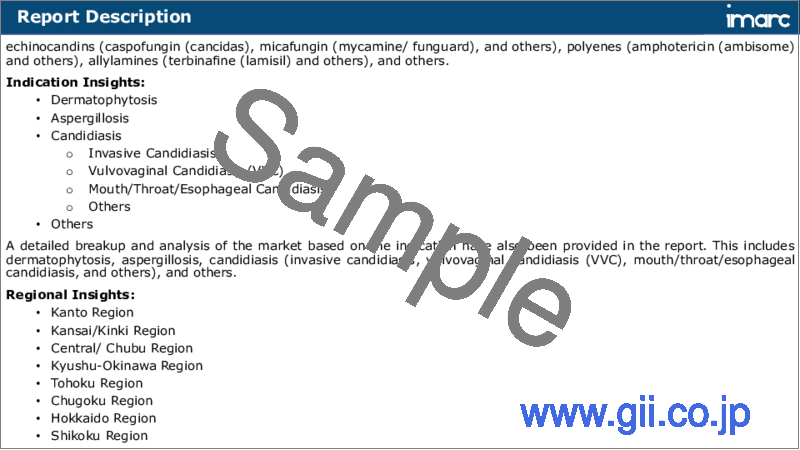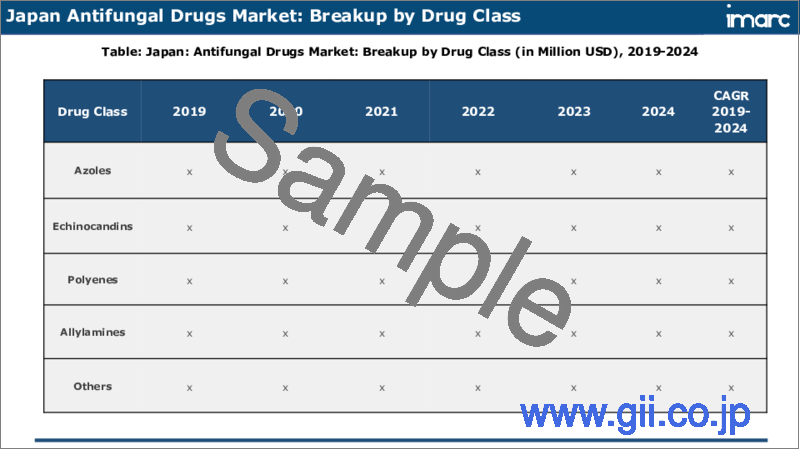|
|
市場調査レポート
商品コード
1747050
日本の抗真菌薬市場:薬剤クラス別、適応症別、地域別レポート、2025~2033年Japan Antifungal Drugs Market Report by Drug Classe (Azoles, Echinocandins, Polyenes, Allylamines, and Others), Indication (Dermatophytosis, Aspergillosis, Candidiasis, Others), and Region 2025-2033 |
||||||
カスタマイズ可能
|
|||||||
| 日本の抗真菌薬市場:薬剤クラス別、適応症別、地域別レポート、2025~2033年 |
|
出版日: 2025年06月02日
発行: IMARC
ページ情報: 英文 118 Pages
納期: 5~7営業日
|
全表示
- 概要
- 目次
日本の抗真菌薬市場規模は2024年に10億8,000万米ドルに達しました。今後、IMARC Groupは、市場は2033年までに16億3,000万米ドルに達し、2025~2033年の成長率(CAGR)は4.47%になると予測しています。免疫不全人口の増加、高齢化、免疫抑制剤の普及など、いくつかの要因に起因する真菌感染症例の増加が市場を牽引しています。
本レポートで扱う主要質問
- 日本の抗真菌薬市場はこれまでどのように推移し、今後どのように推移していくのか?
- COVID-19が日本の抗真菌薬市場に与えた影響は?
- 日本の抗真菌薬市場の薬剤クラス別区分は?
- 日本の抗真菌薬市場の適応症別区分は?
- 日本の抗真菌薬市場のバリューチェーンにおける様々なステージとは?
- 日本における抗真菌薬の主要促進要因と課題は何か?
- 日本の抗真菌薬市場の構造と主要参入企業は?
- 日本の抗真菌薬市場における競合の程度は?
目次
第1章 序文
第2章 調査範囲と調査手法
- 調査の目的
- ステークホルダー
- データソース
- 市場推定
- 調査手法
第3章 エグゼクティブサマリー
第4章 日本の抗真菌薬市場-イントロダクション
- 概要
- 市場力学
- 産業動向
- 競合情報
第5章 日本の抗真菌薬市場情勢
- 過去と現在の市場動向(2019~2024年)
- 市場予測(2025~2033年)
第6章 日本の抗真菌薬市場-薬剤クラス別内訳
- アゾール
- エキノキャンディン
- ポリエン
- アリルアミン
- その他
第7章 日本の抗真菌薬市場-適応症別内訳
- 皮膚糸状菌症
- アスペルギルス症
- カンジダ症
- その他
第8章 日本の抗真菌薬市場-競合情勢
- 概要
- 市場構造
- 市場企業のポジショニング
- 主要成功戦略
- 競合ダッシュボード
- 企業評価象限
第9章 主要企業のプロファイル
第10章 日本の抗真菌薬市場-産業分析
- 促進要因・抑制要因・機会
- ポーターのファイブフォース分析
- バリューチェーン分析
第11章 付録
Japan antifungal drugs market size reached USD 1.08 Billion in 2024. Looking forward, IMARC Group expects the market to reach USD 1.63 Billion by 2033, exhibiting a growth rate (CAGR) of 4.47% during 2025-2033. The increasing cases of fungal infections, attributed to several factors, such as a growing population of immunocompromised individuals, aging people, the widespread use of immunosuppressive drug, etc., are driving the market.
Antifungal drugs are pharmaceutical compounds designed to combat fungal infections in humans, animals, and plants. Fungal infections can range from mild skin conditions to severe, life-threatening systemic illnesses. These drugs work by targeting various aspects of fungal cell growth and function, inhibiting their ability to replicate and spread. There are several classes of antifungal drugs, including azoles, polyenes, echinocandins, and allylamines. Azoles, such as fluconazole and itraconazole, interfere with fungal cell membrane synthesis. Polyenes, like amphotericin B, disrupt fungal cell membranes directly. Echinocandins, including caspofungin, inhibit cell wall formation. Allylamines, such as terbinafine, interfere with fungal enzyme activity. Choosing the appropriate antifungal drug depends on the type and severity of the infection, as well as the patient's health status. Some antifungals are available over-the-counter for topical use, while others require a prescription for systemic infections. It's crucial to use these drugs as prescribed to ensure effectiveness and minimize the risk of drug-resistant fungal strains emerging.
Japan Antifungal Drugs Market Trends:
The antifungal drugs market in Japan is poised for significant growth, primarily due to several interconnected factors. Firstly, the rising incidence of fungal infections serves as a crucial driver. As fungal pathogens become more resistant, the demand for innovative antifungal therapies intensifies. Moreover, the growing elderly population, often with compromised immune systems, increases susceptibility to fungal infections, further propelling market expansion. Secondly, advancements in medical research and biotechnology have paved the way for novel antifungal drug development. Breakthroughs in understanding fungal biology and the discovery of new drug targets have led to a steady influx of innovative therapies. Consequently, pharmaceutical companies are investing heavily in R&D, fostering market growth. Additionally, the rising support from various governments and healthcare organizations in the form of funding and favorable policies to control the spread of fungal infections is expected to drive the antifungal drugs market in Japan during the forecast period.
Japan Antifungal Drugs Market Segmentation:
Drug Class Insights:
- Azoles
- Voriconazole (Vfend)
- Posaconazole (Noxafil)
- Clotrimazole (Canesten)
- Isavuconazole (Cresemba)
- Others
- Echinocandins
- Caspofungin (Cancidas)
- Micafungin (Mycamine/ Funguard)
- Others
- Polyenes
- Amphotericin (AmBisome)
- Others
- Allylamines
- Terbinafine (Lamisil)
- Others
- Others
Indication Insights:
- Dermatophytosis
- Aspergillosis
- Candidiasis
- Invasive Candidiasis
- Vulvovaginal Candidiasis (VVC)
- Mouth/Throat/Esophageal Candidiasis
- Others
- Others
Competitive Landscape:
The market research report has also provided a comprehensive analysis of the competitive landscape. Competitive analysis such as market structure, key player positioning, top winning strategies, competitive dashboard, and company evaluation quadrant has been covered in the report. Also, detailed profiles of all major companies have been provided.
Key Questions Answered in This Report:
- How has the Japan antifungal drugs market performed so far and how will it perform in the coming years?
- What has been the impact of COVID-19 on the Japan antifungal drugs market?
- What is the breakup of the Japan antifungal drugs market on the basis of drug class?
- What is the breakup of the Japan antifungal drugs market on the basis of indication?
- What are the various stages in the value chain of the Japan antifungal drugs market?
- What are the key driving factors and challenges in the Japan antifungal drugs?
- What is the structure of the Japan antifungal drugs market and who are the key players?
- What is the degree of competition in the Japan antifungal drugs market?
Table of Contents
1 Preface
2 Scope and Methodology
- 2.1 Objectives of the Study
- 2.2 Stakeholders
- 2.3 Data Sources
- 2.3.1 Primary Sources
- 2.3.2 Secondary Sources
- 2.4 Market Estimation
- 2.4.1 Bottom-Up Approach
- 2.4.2 Top-Down Approach
- 2.5 Forecasting Methodology
3 Executive Summary
4 Japan Antifungal Drugs Market - Introduction
- 4.1 Overview
- 4.2 Market Dynamics
- 4.3 Industry Trends
- 4.4 Competitive Intelligence
5 Japan Antifungal Drugs Market Landscape
- 5.1 Historical and Current Market Trends (2019-2024)
- 5.2 Market Forecast (2025-2033)
6 Japan Antifungal Drugs Market - Breakup by Drug Class
- 6.1 Azoles
- 6.1.1 Overview
- 6.1.2 Historical and Current Market Trends (2019-2024)
- 6.1.3 Market Segmentation
- 6.1.3.1 Voriconazole (Vfend)
- 6.1.3.2 Posaconazole (Noxafil)
- 6.1.3.3 Clotrimazole (Canesten)
- 6.1.3.4 Isavuconazole (Cresemba)
- 6.1.3.5 Others
- 6.1.4 Market Forecast (2025-2033)
- 6.2 Echinocandins
- 6.2.1 Overview
- 6.2.2 Historical and Current Market Trends (2019-2024)
- 6.2.3 Market Segmentation
- 6.2.3.1 Caspofungin (Cancidas)
- 6.2.3.2 Micafungin (Mycamine/ Funguard)
- 6.2.3.3 Others
- 6.2.4 Market Forecast (2025-2033)
- 6.3 Polyenes
- 6.3.1 Overview
- 6.3.2 Historical and Current Market Trends (2019-2024)
- 6.3.3 Market Segmentation
- 6.3.3.1 Amphotericin (AmBisome)
- 6.3.3.2 Others
- 6.3.4 Market Forecast (2025-2033)
- 6.4 Allylamines
- 6.4.1 Overview
- 6.4.2 Historical and Current Market Trends (2019-2024)
- 6.4.3 Market Segmentation
- 6.4.3.1 Terbinafine (Lamisil)
- 6.4.3.2 Others
- 6.4.4 Market Forecast (2025-2033)
- 6.5 Others
- 6.5.1 Historical and Current Market Trends (2019-2024)
- 6.5.2 Market Forecast (2025-2033)
7 Japan Antifungal Drugs Market - Breakup by Indication
- 7.1 Dermatophytosis
- 7.1.1 Overview
- 7.1.2 Historical and Current Market Trends (2019-2024)
- 7.1.3 Market Forecast (2025-2033)
- 7.2 Aspergillosis
- 7.2.1 Overview
- 7.2.2 Historical and Current Market Trends (2019-2024)
- 7.2.3 Market Forecast (2025-2033)
- 7.3 Candidiasis
- 7.3.1 Overview
- 7.3.2 Historical and Current Market Trends (2019-2024)
- 7.3.3 Market Segmentation
- 7.3.3.1 Invasive Candidiasis
- 7.3.3.2 Calcium Carbonate
- 7.3.3.3 Vulvovaginal Candidiasis (VVC)
- 7.3.3.4 Mouth/Throat/Esophageal Candidiasis
- 7.3.3.5 Others
- 7.3.4 Market Forecast (2025-2033)
- 7.4 Others
- 7.4.1 Historical and Current Market Trends (2019-2024)
- 7.4.2 Market Forecast (2025-2033)
8 Japan Antifungal Drugs Market - Competitive Landscape
- 8.1 Overview
- 8.2 Market Structure
- 8.3 Market Player Positioning
- 8.4 Top Winning Strategies
- 8.5 Competitive Dashboard
- 8.6 Company Evaluation Quadrant
9 Profiles of Key Players
- 9.1 Company A
- 9.1.1 Business Overview
- 9.1.2 Product Portfolio
- 9.1.3 Business Strategies
- 9.1.4 SWOT Analysis
- 9.1.5 Major News and Events
- 9.2 Company B
- 9.2.1 Business Overview
- 9.2.2 Product Portfolio
- 9.2.3 Business Strategies
- 9.2.4 SWOT Analysis
- 9.2.5 Major News and Events
- 9.3 Company C
- 9.3.1 Business Overview
- 9.3.2 Product Portfolio
- 9.3.3 Business Strategies
- 9.3.4 SWOT Analysis
- 9.3.5 Major News and Events
- 9.4 Company D
- 9.4.1 Business Overview
- 9.4.2 Product Portfolio
- 9.4.3 Business Strategies
- 9.4.4 SWOT Analysis
- 9.4.5 Major News and Events
- 9.5 Company E
- 9.5.1 Business Overview
- 9.5.2 Product Portfolio
- 9.5.3 Business Strategies
- 9.5.4 SWOT Analysis
- 9.5.5 Major News and Events
10 Japan Antifungal Drugs Market - Industry Analysis
- 10.1 Drivers, Restraints, and Opportunities
- 10.1.1 Overview
- 10.1.2 Drivers
- 10.1.3 Restraints
- 10.1.4 Opportunities
- 10.2 Porters Five Forces Analysis
- 10.2.1 Overview
- 10.2.2 Bargaining Power of Buyers
- 10.2.3 Bargaining Power of Suppliers
- 10.2.4 Degree of Competition
- 10.2.5 Threat of New Entrants
- 10.2.6 Threat of Substitutes
- 10.3 Value Chain Analysis






